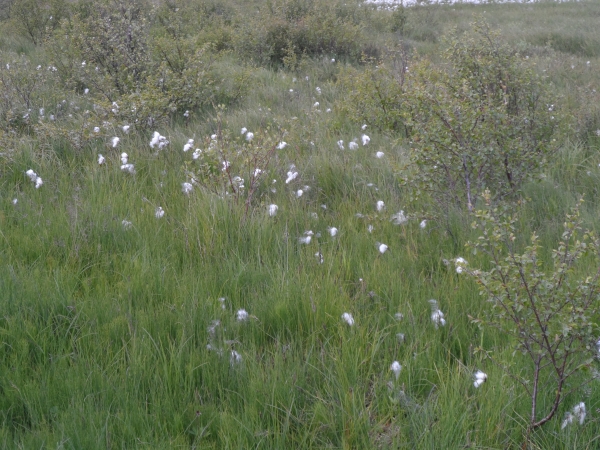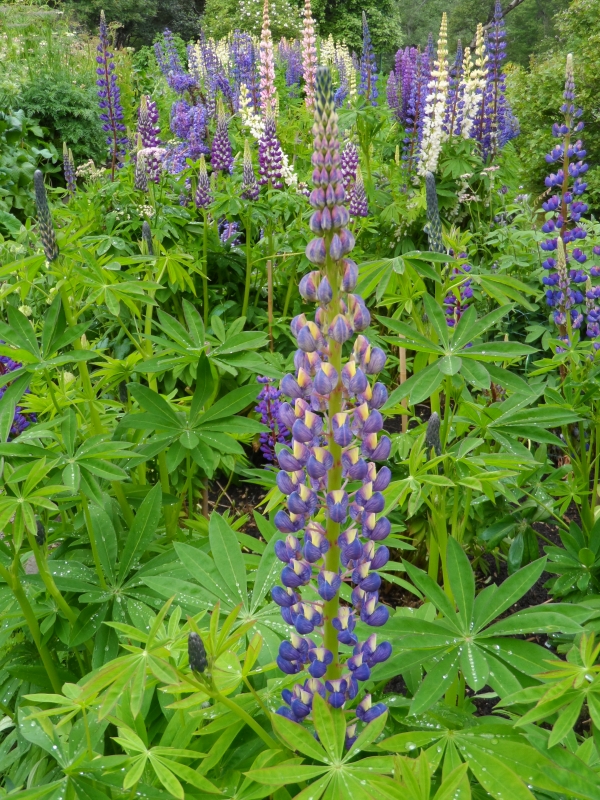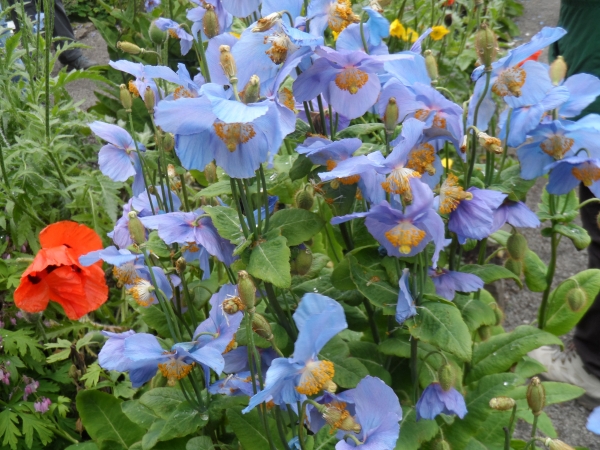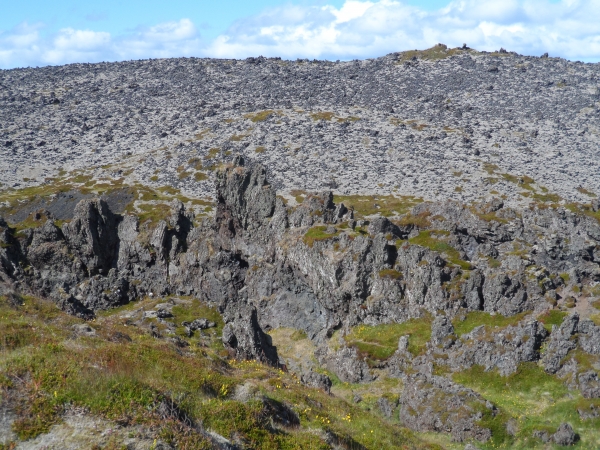Text by Victoria Mather
I recently completed a wonderful 10 day tour of Iceland. I expected to see glaciers and waterfalls, rivers and mountains, volcanoes, less ice than its name implies and grand scenery. I expected a delightful visual experience. But what I did not expect were flowers. Lots and lots of flowers! They were everywhere. As a gardener, this surprised me every single day. While my fellow tourists were snapping pictures of towering cliffs, I was snapping pictures of the beauty at my feet.
Cottony beauty
It was astonishing to me to see such a variety of wildflowers. Some we would call weeds, like dandelions, but in that environment, so close to the Arctic Circle, they were unexpected. Most of the wild flowers were small and grew close to the ground, adapting, I assume, to protect themselves from the wind and cold. When I travel, I try to be open to what is new and different about a country. Iceland gave me many new beauties to feast on.

For instance, as we travelled the island, I kept noticing white tufts of something in the grass that did not look to me like a flower. From the bus window it resembled cotton balls. On closer inspection I found them to be tufts of soft cottony fibres growing on a stem. I had never seen anything like it! Cotton grass it is called. It was used in earlier days as a lamp wick or enjoyed by folks like me for its cottony beauty.
I kept noticing white tufts of something in the grass that did not look to me like a flower.
A plant with controversial history
I shouldn’t be surprised by the presence of dandelions, which I’ve seen in all my travels around the world but I always am. However, I’m not surprised by tales of invasive plants. On our first days’ tour the beautiful blue lupines we saw everywhere were dazzling; so lovely and colourful even as we learned their controversial history. Lupines, (Lupinus nootkatenis), were brought in during the 1950’s to try and prevent soil erosion.

Iceland is “assaulted” by wind and rain and snow. It’s hard to get the soil to stay put. Especially since most of the native forests were felled during the settlement of the land about 1100 years ago. I did expect more trees in Iceland, and I’m sad for them that so many were lost. Reforestation is happening in many areas of the island, but it is slow probably due to the short growing season and a need for public money to be spent elsewhere. Unfortunately, the lupines turned out to be invasive and they don’t share well with the tiny Icelandic natives. They take over and crowd out the precious and delicate Icelandic wildflowers. I admire the groups of gardeners that are working to replace the lupines with plants that won’t harm their native beauties.
There are very few truly blue flowers in the world. These poppies must be at the top of the list.
One of the world’s northern most botanical gardens
Part of our tour included a visit to one of the northern-most botanical gardens in the world. 40 miles from the Arctic Circle, it was founded in 1961 in the city of Reykjavik. Its vast collection of plants, about 7000 species, shows off the incredible diversity of growing things in the northern temperate zone.

My breath was taken away by their beds of Icelandic Blue Poppies. There are very few truly blue flowers in the world. These poppies must be at the top of the list. I was also impressed by their reverence for the gentleman who wrote their national anthem. The Icelandic national anthem: Ó, guð vors lands (Our country's God) was written by one of Iceland’s best loved poets, Rev. Matthías Jochumsson. A large bust of the Reverend is present in the garden along with busts of two of the leading forces behind the creation of the gardens, Margarethe Schiöth and Jón Rögnvaldsson whose plant collection was the basis of the garden. The garden was lovely and I could have spent many happy hours there.
It wasn’t just the flowers that were blooming but also acres of moss and lichens that covered the volcanic lava fields, acre upon acre.
Don’t look up, look down
On another day, we visited a commercial greenhouse where I took photos of the most perfect flowers. Another Icelandic surprise!
Other things that impressed me were the floral displays in the larger cities, a sure sign that these are communities that care. Flowers were present in windowsills, in large containers at street corners and along many commercial sidewalks.

It wasn’t just the flowers that were blooming but also acres of moss and lichens that covered the volcanic lava fields, acre upon acre. These were just as spectacular to my eye as the waterfalls. Iceland has a very special kind of beauty and you don’t always have to look up to see it.
Text by Victoria Mather
I recently completed a wonderful 10 day tour of Iceland. I expected to see glaciers and waterfalls, rivers and mountains, volcanoes, less ice than its name implies and grand scenery. I expected a delightful visual experience. But what I did not expect were flowers. Lots and lots of flowers! They were everywhere. As a gardener, this surprised me every single day. While my fellow tourists were snapping pictures of towering cliffs, I was snapping pictures of the beauty at my feet.
Cottony beauty
It was astonishing to me to see such a variety of wildflowers. Some we would call weeds, like dandelions, but in that environment, so close to the Arctic Circle, they were unexpected. Most of the wild flowers were small and grew close to the ground, adapting, I assume, to protect themselves from the wind and cold. When I travel, I try to be open to what is new and different about a country. Iceland gave me many new beauties to feast on.

For instance, as we travelled the island, I kept noticing white tufts of something in the grass that did not look to me like a flower. From the bus window it resembled cotton balls. On closer inspection I found them to be tufts of soft cottony fibres growing on a stem. I had never seen anything like it! Cotton grass it is called. It was used in earlier days as a lamp wick or enjoyed by folks like me for its cottony beauty.
I kept noticing white tufts of something in the grass that did not look to me like a flower.
A plant with controversial history
I shouldn’t be surprised by the presence of dandelions, which I’ve seen in all my travels around the world but I always am. However, I’m not surprised by tales of invasive plants. On our first days’ tour the beautiful blue lupines we saw everywhere were dazzling; so lovely and colourful even as we learned their controversial history. Lupines, (Lupinus nootkatenis), were brought in during the 1950’s to try and prevent soil erosion.

Iceland is “assaulted” by wind and rain and snow. It’s hard to get the soil to stay put. Especially since most of the native forests were felled during the settlement of the land about 1100 years ago. I did expect more trees in Iceland, and I’m sad for them that so many were lost. Reforestation is happening in many areas of the island, but it is slow probably due to the short growing season and a need for public money to be spent elsewhere. Unfortunately, the lupines turned out to be invasive and they don’t share well with the tiny Icelandic natives. They take over and crowd out the precious and delicate Icelandic wildflowers. I admire the groups of gardeners that are working to replace the lupines with plants that won’t harm their native beauties.
There are very few truly blue flowers in the world. These poppies must be at the top of the list.
One of the world’s northern most botanical gardens
Part of our tour included a visit to one of the northern-most botanical gardens in the world. 40 miles from the Arctic Circle, it was founded in 1961 in the city of Reykjavik. Its vast collection of plants, about 7000 species, shows off the incredible diversity of growing things in the northern temperate zone.

My breath was taken away by their beds of Icelandic Blue Poppies. There are very few truly blue flowers in the world. These poppies must be at the top of the list. I was also impressed by their reverence for the gentleman who wrote their national anthem. The Icelandic national anthem: Ó, guð vors lands (Our country's God) was written by one of Iceland’s best loved poets, Rev. Matthías Jochumsson. A large bust of the Reverend is present in the garden along with busts of two of the leading forces behind the creation of the gardens, Margarethe Schiöth and Jón Rögnvaldsson whose plant collection was the basis of the garden. The garden was lovely and I could have spent many happy hours there.
It wasn’t just the flowers that were blooming but also acres of moss and lichens that covered the volcanic lava fields, acre upon acre.
Don’t look up, look down
On another day, we visited a commercial greenhouse where I took photos of the most perfect flowers. Another Icelandic surprise!
Other things that impressed me were the floral displays in the larger cities, a sure sign that these are communities that care. Flowers were present in windowsills, in large containers at street corners and along many commercial sidewalks.

It wasn’t just the flowers that were blooming but also acres of moss and lichens that covered the volcanic lava fields, acre upon acre. These were just as spectacular to my eye as the waterfalls. Iceland has a very special kind of beauty and you don’t always have to look up to see it.







